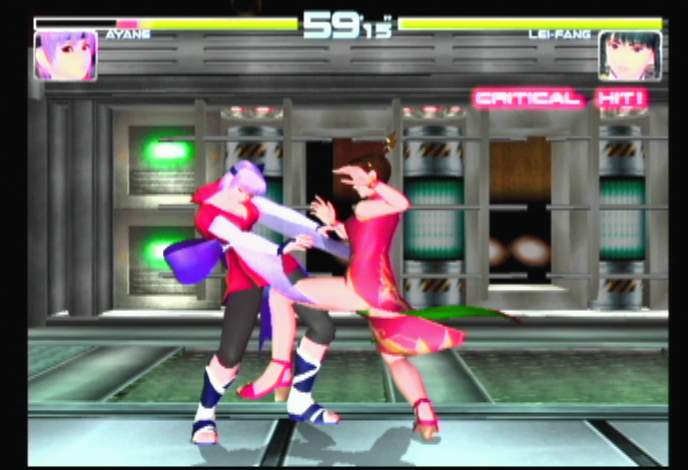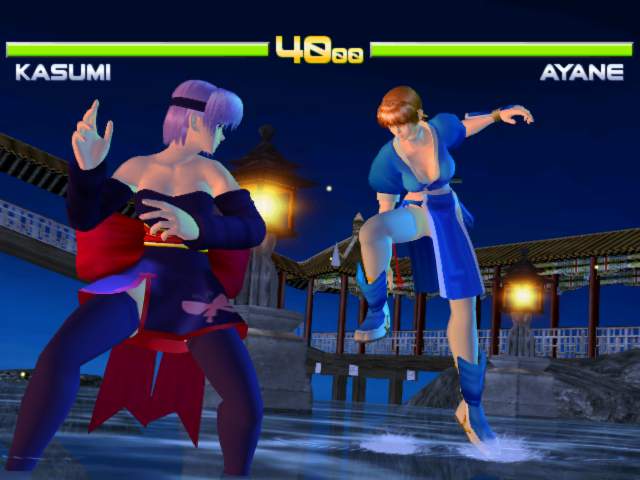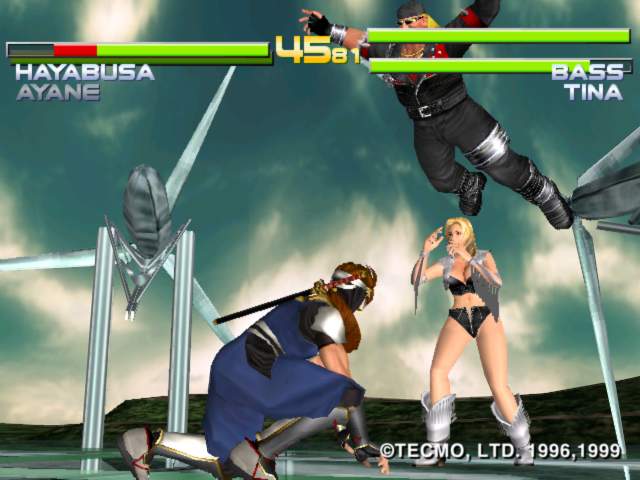Dead or Alive 2
Review - a beat-em-up to rival Soul Calibur? Surely not..

Sold on sex
I think it can safely be said that if nothing else, Sega's Saturn had its fair share of decent beat-em-ups. One of the best was Tecmo's fabulous Dead or Alive, preferred by many to Virtua Fighter 2 and Namco's Tekken 3, regarded as the epitome of fighting style elsewhere. As such when Sega announced that the follow-up was winging its way over here, it could be said that a lot of people were a bit chuffed. Quite a while later, and despite the rather risqué advertising campaigns surrounding it, it's here, in all its effervescent glory. Playing DOA2 for the first time is a bit like entering an arcade with bleary eyes and an unhealthy dosage of mind-altering drugs. It's fast, frenetic beat-em-up action with a simplistic control system and a disproportionately large quantity of moves per character. Due to the speed of the game and concise controls (you have a punch, kick and block/hold button, each instantaneously responsive), winning against decent opponents is very much down to the timing, which makes a pleasant change after the thumb pounding of some recent titles. Specialist moves like tagging and throwing can be bound to specific buttons, although as the DC controller has a paltry six this can be somewhat limited in its effectiveness and you'll have to experiment before deciding upon which moves are most potent in the majority of situations.

Battling on a knife-edge
DOA2's combat system is very original compared to most fighters, which play themselves out in a very back-and-forth style. With DOA2 you can turn aside incoming attacks and even use the other fighter's over-extension to your advantage, grabbing a limb and using it to inflict pain upon your opponent. The controls are thankfully utterly intuitive, so if you pick up the title not really knowing to expect as a veteran of Soul Calibur or perhaps the Street Fighter series, it won't take you long to adapt. Defending and attacking is almost as blurred as some of the most frenetic attacks, which seem to move faster than you can keep track of at times, despite the consistent 60 frames per second. Every defensive move can be the start of a vicious offence, and if you're caught out, the chances are your attack will revert to defence; and so it alternates until you're really unconvinced by the distinction and happy to carry on ignorant of it. Lamentably though there's not enough to keep you going. Although there are plenty of dressed up game modes such as story, time attack and tournament, once you've gone through them (and thanks to the almost horizontal learning curve this isn't too difficult) there's not much else left beyond the bare bones fighter. Soul Calibur by comparison is a veritable treasure chest of longevity. Unless you have some equally addicted friends who spend 90% of the day at your house, DOA2 will quickly become a game to pull out on post-pub occasions and little else, which is a shame.

Beauty is in the eye of the beholder
Although it's not going to keep you coming back for as long as Soul Calibur did, it's still one of the most beautiful and playable games on the console. In terms of visuals, there aren't enough effectual adjectives to satisfy my taste for them. The character models are stunning, especially the women, although more from a technical standpoint than anything else. The curves and contours of all the characters' bodies, not least the women are very realistic, and the way in which they move is lifelike to the last. Incidentally, whatever Sega may tell you, the magazines across which Tina, Kasumi and co. have been draped are only a slide of the eyes away from the glamorous lads mags and their more endearing full-page spreads; People will stick to the real stuff guys, so give up! One of the things that was given a lot of attention in Soul Calibur was its sumptuously detailed backdrops. At closer inspection however it became apparent that that is all they were, backgrounds. DOA2 ups the ante a little with truly interactive locations, such as a Tibetan Palace with four whole floors of lavishness to be thrown about on. A far cry from a few nice landscapes wrapped around an arena.

A term of endearment
Ultimately, Dead or Alive 2 is a top beat-em-up, but it isn't going to last. The real shame here is that the reasons for this are so plain and obvious that it's truly despairing that it didn't occur to Tecmo to do something about them. In effect what they've done is to taken the arcade incarnation of the game and allowed Dreamcast owners unrestricted access to all of it. There's no progressive release of extras; no new costumes for fighters (which kept DOA fans ticking over for many months), no secret characters, no nothing, and with the average character's single player game taking about 10-15 minutes to complete you'll be through it quicker than is comfortable. And what's left beyond the single player game? Multiplayer. This is utterly brilliant and frankly how the game should be played, but it does rather limit the game to multiple player situations, and although this might even be fine if you could play over the net or modem, those options aren't at your disposal, so it's a case of finding a willing and similarly skilled friend or sibling to battle against. Sigh.
Conclusion
When the chips are down, Dead or Alive 2 is one of the best beat-em-ups on the Dreamcast, and rather amusingly, a lot of people whose opinions count rate it more so than they do the PlayStation 2 version, but without the added longevity of games like Powerstone and Soul Calibur, it'll be warming the shelf within a week or two.








